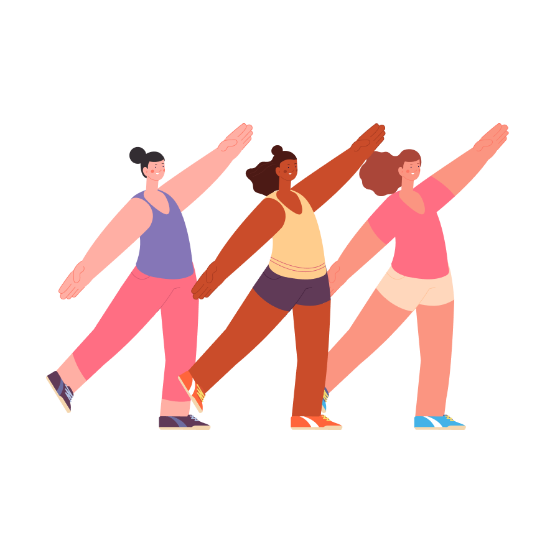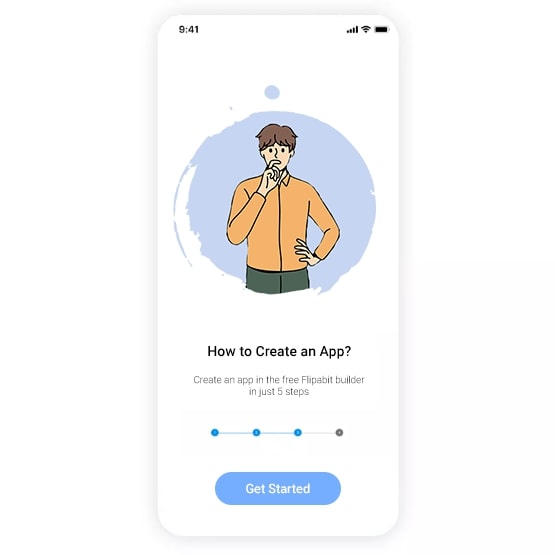Exercising, participating in sports, and leading a healthy lifestyle are more popular than ever before. Wearable devices such as smartwatches and fitness bracelets are encouraging many people to exercise more frequently. These factors have led to a significant increase in the demand for fitness apps.


Create a workout app for Android or iOS with the Flipabit following these steps:
The main purpose of workout apps is to show which exercises will help you achieve specific goals and how to perform them correctly. They include workout plans with video tutorials and explanations of each movement.
These apps help users manage their weight and hydration levels, and maintain a healthy diet (by making shopping lists and finding recipes). They can also track coffee intake, calories burned, and body fat percentage.
These are apps for spirituality, meditation, and yoga. They include motivational audio and video content with timed pauses. They help to master the practice of meditation, track sleeping patterns, and water intake.
These are apps that combine the functionality of several different applications. It could be an app from a famous coach, or a sporting goods manufacturer.
An account allows a user’s information to be saved across multiple devices. Plus, without an account, the competitive aspect of the app is lost because the user won’t be able to compare stats and achievements with friends.
Exercise is numbers. Calories, miles, sets and repetitions are all important as they motivate the user to keep using the app to achieve more.
Exercise apps help in making physical results measurable. And since the desired results are set by the user, the process of achieving the goal should be as simple and straightforward as possible. For example, if a user wants to gain 10 pounds of muscle mass over a particular period, then the application lays out a detailed workout schedule to meet that goal.
Synching with smartwatches and fitness trackers means a person can exercise whenever and wherever they want without having to take their bulky smartphone with them. Plus, a wearable device allows one to monitor their heart rate, distance, pace, and calories burned, which is extremely important for tracking activity and progress.
Push notifications can be used as reminders to eat, drink, or start a workout, in addition to showing when a user has traveled a certain distance or reached a goal.
Tutorials that demonstrate a workout or specific movement are helpful for visual learners and those who need support and guidance, even if in a virtual form.
People love to share their achievements on social media. Developers can use this tendency to their advantage, motivating the user to use the application more after achieving a goal while also increasing awareness and expanding the user base.

The basic features of the app are free, while additional advanced features can be unlocked for a fee. The user may receive new workouts, video tutorials, or simply no ads.
The app is free, but it contains digital products and services like customized diet plans, workouts, one-on-one consultations with a fitness coach, and more.
Often used to monetize free fitness apps with large audiences. If the application targets a niche market with low traffic, then you shouldn’t expect exceptionally high profits.
Referral links embedded in the application direct users to online stores for sports shoes, exercise equipment, nutrition, and more. For every customer referral, the application owner receives a certain percentage of the profit.
The user downloads the application for free, but access to certain content or functions only comes with a paid subscription for a certain amount of time. This is one of the most profitable monetization models.
The global fitness app market is expected to grow at an average rate of 21.6% between 2021 and 2028.
The global fitness app market is expected to reach by 2028
The total number of Fitness app users in 2021
Of Americans have used one or more fitness apps during the pandemic
Fitness apps are services designed to improve physical fitness and encourage healthier living. They can be tools for gaining muscle mass, losing weight, recovering from an illness, and tracking physical activity.
Fitness and exercise apps can be used to complement a classic workout with a trainer, chat with a dietitian, or serve as an alternative in itself. For many people, the latter is the only option. The number of active users in this category continues to grow year after year, and here’s why:
Personalization. Personalization can improve the user’s experience while increasing your bottom line. If the user feels that the app is meeting their personal needs and helping them achieve their fitness goals, then they will keep coming back.
Tracking Activity and Progress. Users love to track their miles and steps, set goals, and monitor progress. Trackable parameters can vary from application to application. For example, if an app is designed to help with weight loss, then it will need to monitor the number of calories burned and pounds lost.
Gamification. Gamification entails applying the principles of video games to a non-gaming environment. Businesses are said to do better when work becomes a game with a reward system, rather than being an obligation. The same is true for physical exercise. An application may employ features commonly found in video games such as levels, quests, badges and points.
Community. Building a community around your fitness app is the best way to attract and retain users. By seeing how friends or celebrities are achieving their fitness goals with your app, users will realize its value.
Training Videos. Videos increase motivation, allow for training at home or while on vacation, and ensure proper technique as demonstrated by the trainer.
See how Flipabit can help you create an app you'll love
The Flipabit App Maker lets you build a training or wellness app, diet planner or calorie counter. With features to increase users engagement and powerful monetization tools, it's easy to create your own workout app.